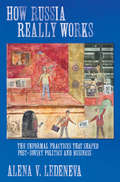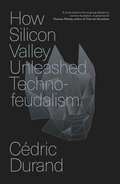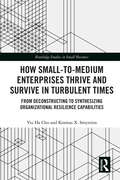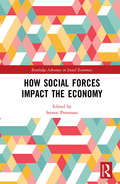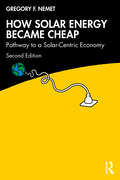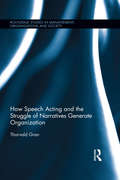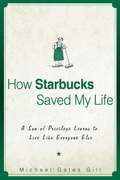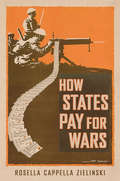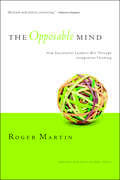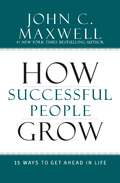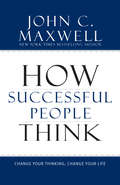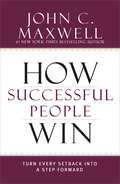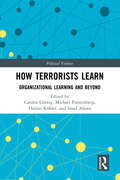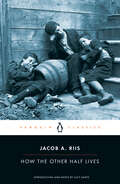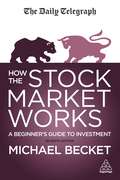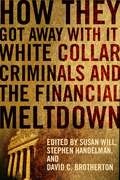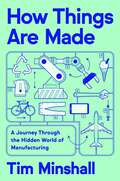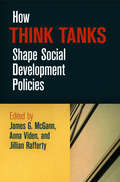- Table View
- List View
How Russia Really Works: The Informal Practices That Shaped Post-Soviet Politics and Business (Culture and Society after Socialism)
by Alena V. LedenevaDuring the Soviet era, blat--the use of personal networks for obtaining goods and services in short supply and for circumventing formal procedures--was necessary to compensate for the inefficiencies of socialism. The collapse of the Soviet Union produced a new generation of informal practices. In How Russia Really Works, Alena V. Ledeneva explores practices in politics, business, media, and the legal sphere in Russia in the 1990s--from the hiring of firms to create negative publicity about one's competitors, to inventing novel schemes of tax evasion and engaging in "alternative" techniques of contract and law enforcement. Ledeneva discovers ingenuity, wit, and vigor in these activities and argues that they simultaneously support and subvert formal institutions. They enable corporations, the media, politicians, and businessmen to operate in the post-Soviet labyrinth of legal and practical constraints but consistently undermine the spirit, if not the letter, of the law. The "know-how" Ledeneva describes in this book continues to operate today and is crucial to understanding contemporary Russia.
How Serial Entrepreneurs Build and Manage a Board of Directors in a Venture-Backed Start Up
by William A. Sahlman Michael J. Roberts Sasha NovakovichThis case includes structured interviews with four serial entrepreneurs about the way in which they built and used their boards in each of their companies and what they have learned through that process. These entrepreneurs were asked similar questions, such as "How do you build a board of directors in a venture-backed start up?" "What do you expect of the board and how do you ensure those expectations are met?" "What are the most and least value-added board activities?" "How do you manage the board?" "How does board composition change over time?" "What were your biggest surprises about boards?" and "What advice would you give first-time entrepreneurs?"
How Should Netflix Add an Ad-Supported Tier?
by Elie Ofek Olivier ToubiaIn the summer of 2022, it became clear that Netflix would introduce an ad-supported tier alongside its existing subscription plans in the near future. Speculation abounded as to the details of the new tier: How many minutes of advertising would it include? What picture quality would it offer? How many screens could be viewed at the same time? And, critically, how much would it cost the consumer per month? In this exercise, students are tasked with trying to assess whether Netflix should indeed go ahead with introducing a new ad-supported tier - and if so, how? - or whether the company would be better off sticking with its existing tiers and repricing them - and if so, by how much? Students need to evaluate which of these options would maximize the number of subscribers, and importantly, profits. Students have at their disposal results from market research (specifically a conjoint analysis study), financial reports, and industry data. The exercise also allows for a conceptual discussion of the merits of alternative revenue models: ad-driven vs. pure subscription-driven vs. a hybrid of the two.
How Should You Pick Your Targets?: Mastering the Merger
by David Harding Sam RovitDetermining what you want to buy should be deeply rooted in understanding your current business: selecting your targets is all about reinforcing your core. This chapter focuses on the first of the four key deal-making decisions: the all-important process of picking your targets.
How Silicon Valley Unleashed Techno-Feudalism: The Making of the Digital Economy
by Cédric DurandThe promise of the New Economy gone, we have regressed into the age of techno-feudalismThe rise of the IT industry in the nineties promised a new era of freedom and prosperity. It didn&’t deliver. Certainly, algorithms are everywhere, but capitalism is no more civilised than ever.In fact, in the hands of private corporations, the digitalisation of the world drives us towards a darker future. The return of monopolies, the dominance of a few platforms, the blurred distinction between the economic and the political all epitomise a systemic mutation. Information and data networks push the digital economy in the direction of the feudal logic of rent, dispossession, and personal domination.How Silicon Valley Unleashed Techno-feudalism offers a fresh genealogy of the Silicon Valley consensus and its contradictions. It disentangles the principles of an emerging systemwide rationale. Large firms compete in cyberspace to gain control over data, and ordinary people are increasingly at the mercy of tech giants. In this new economic order, capital is moving away from production to focus on predation.
How Small-to-Medium Enterprises Thrive and Survive in Turbulent Times: From Deconstructing to Synthesizing Organizational Resilience Capabilities (Routledge Studies in Small Business)
by Yiu Ha Chu Kosmas SmyrniosPolitical and financial upheaval is not a new phenomenon – from the tulip bulb bubble in the Netherlands in the seventeenth century to Black Monday in 1987, businesses throughout history have worked to adapt and cope. However, today’s climate is even more fraught with crises, raising the levels of concern for business, society, and governments. It especially poses a challenge for small businesses, who have to learn to cope with this increasingly turbulent environment, dealing with the difficulties and taking advantage of the new opportunities that turbulence can provide. Understanding how resilience capabilities can be developed to promote sustainable business is imperative. This book provides a new paradigm for conceptualizing resilience capabilities and advances current understanding both theoretically and practically in real-world business settings. Examining the processes of resilience during different phases of crisis reveals why businesses either fail, or outperform their counterparts during times of turbulence. Based on in-depth empirical research, researchers and advanced students in small business, strategic management and risk management will find this an invaluable guide to organizational resilience.
How Smart are Cities without Adequate Finances?: A Comparative Analysis in South Asia (SpringerBriefs in Economics)
by Simanti Bandyopadhyay Firdousi Naher Aishna SharmaThis book compares urban finances in cities located in two different South Asian countries and assesses their fiscal health. It uses simulation to estimate the required augmentation in financial resources by the urban local bodies (ULBs) to reach a level of city development that is significantly better compared to existing levels. The book provides a systematic analysis of the fiscal health of two city corporations in Bangladesh, viz. Dhaka North City Corporation (DNCC) and Dhaka South City Corporation (DSCC); and one city corporation in the Indian state of West Bengal viz. Kolkata Municipal Corporation (KMC). The choice of city corporations was based on the shared history and the similarity of heritage, culture, topography and socio-economic conditions. Both DNCC and DSCC as well as the KMC have a high population density, which puts immense pressure on the service delivery provided by these corporations of basic services such as water supply, sanitation facilities, street lighting, drainage and sewerage and waste disposal. This is compounded by poor fiscal health of the ULBs. Using primary data collected through surveys and personal interviews and information obtained from official documents, the book estimates fiscal gaps of the ULBs and undertakes simple simulations to estimate potential revenue enhancements and expenditure requirements to deliver services at the internationally acceptable standards. It highlights under-exploited sources of revenue which can be better realized and also identifies untapped revenue sources that can be easily introduced, in order to significantly enhance city revenues. The book is an excellent resource not only for researchers studying this topic, but also for policy makers and urban planners, particularly those from developing countries having to deal with burgeoning cities with high migrant population density.
How SmithKline Beecham Makes Better Research-Allocation Decisions
by Paul Sharpe Tom KeelinShrinking R&D budgets and shorter product life cycles mean investment dollars must be invested with precision if companies are going to stay on the cutting edge in their industries. For a pharmaceuticals company like SmithKline Beecham (SB), the problem is this: How do you make good decisions in a high-risk, technically complex business when the information you need to make those decisions comes largely from the project champions who are competing against one another for resources? Tom Keelin from Strategic Decisions Group and Paul Sharpe from SmithKline Beecham explain how they overhauled the resource allocation processes within the pharmaceutical development function at SB. In 1993, the company experimented with ways of depoliticizing the process and improving the quality of decision making. In most resource-allocation processes, project advocates develop a single plan of action and present it as the only viable approach. In SB's new process, the company found an effective way to get around the all-or-nothing thinking that only reinforces the project-champion culture. In another important departure from common practice, SB separated the discussion of project alternatives from their financial evaluations. The new process at SB has allowed the organization to spend less time arguing about how to value its R&D projects and more time figuring out how to make them more valuable. In the end, the company learned that by tackling the soft issues around resource allocation--such as information quality, credibility, and trust--it had also addressed the hard ones: how much to invest and where to invest it.
How Social Forces Impact the Economy (Routledge Advances in Social Economics)
by Steven PressmanSocial forces are important determinants of how people behave, how economies work at the macroeconomic level, and the effectiveness of economic policies. However, this dimension is generally overlooked in mainstream economics. How Social Forces Impact the Economy demonstrates that a broader conception of social economics provides for a better understanding of how economies work as a whole. This book argues that adopting a truly social approach to economics opens the door to studying how people form preferences, and how they learn by taking cues from others about how to behave and what to consume. Each chapter contributor works to highlight the breadth of new insights and possibilities that emerge from a fuller understanding of social economics. Part I focuses on microeconomics, bringing individual behaviors and individual entrepreneurs into a more social context. Part II focuses on macroeconomic topics, such as how money and quasi-monies (like Bitcoins) are social, how money developed as a social institution, and how social forces matter for economic development. Finally, Part III looks at the consequences of considering social factors when it comes to policy: environmental policy, industrial policy, and policies promoting greater equality. This book is invaluable reading to anyone interested in the relationship between economics and sociology, how social forces affect policy effectiveness, human behavior, and the overall economy.
How Solar Energy Became Cheap: A Model for Low-Carbon Innovation
by Gregory F. NemetSolar energy is a substantial global industry, one that has generated trade disputes among superpowers, threatened the solvency of large energy companies, and prompted serious reconsideration of electric utility regulation rooted in the 1930s. One of the biggest payoffs from solar’s success is not the clean inexpensive electricity it can produce, but the lessons it provides for innovation in other technologies needed to address climate change. Despite the large literature on solar, including analyses of increasingly detailed datasets, the question as to how solar became inexpensive and why it took so long still remains unanswered. Drawing on developments in the US, Japan, Germany, Australia, and China, this book provides a truly comprehensive and international explanation for how solar has become inexpensive. Understanding the reasons for solar’s success enables us to take full advantage of solar’s potential. It can also teach us how to support other low-carbon technologies with analogous properties, including small modular nuclear reactors and direct air capture. However, the urgency of addressing climate change means that a key challenge in applying the solar model is in finding ways to speed up innovation. Offering suggestions and policy recommendations for accelerated innovation is another key contribution of this book. This book will be of great interest to students and scholars of energy technology and innovation, climate change and energy analysis and policy, as well as practitioners and policymakers working in the existing and emerging energy industries.
How Solar Energy Became Cheap: Pathway to a Solar-Centric Economy
by Gregory F. NemetThe climate problem is getting worse, but the solutions are getting better. So far, no technology has done more to improve the solutions available to address climate change than solar photovoltaics (PV). This revised edition describes an array of driving forces leading us toward a solar-centric energy system, one where solar power lies at the core rather than at the edge.Now in its second edition the book focuses on the future of solar, taking into account important changes since it was first published. It includes discussions on further growth and cost reductions, industrial policy, and grid integration of high solar. It has been fully revised to include the most recent data available, and includes two new chapters on India, the most important solar market in the Global South, and Australia, the fastest growing market for rooftop solar. The book concludes with a new chapter on a solar-centric economy. The costs of solar PV modules have reduced significantly since they were first commercialized and, in sunny places, are now cheaper than any other form of electricity. Drawing on developments in the US, Japan, Germany, Australia, India, and China, the book analyses the evolution and success of PV and asks how it can serve as a model for other low-carbon technologies, which require urgent innovation to address climate change.It will be of great interest to students and scholars of energy technology and innovation, climate change and energy analysis and policy, as well as practitioners and policymakers working in the energy industries.
How Speech Acting and the Struggle of Narratives Generate Organization (Routledge Studies in Management, Organizations and Society)
by Thorvald GranHow Speech Acting and the Struggle of Narratives Generate Organization seeks to shed understanding on how speaking or speech-acting affects how we are organized and how we influence each other and wield power. It is suggested that speaking is a major clue to organization and to the creation of new organizations. The task is to describe how speech-acting organizes. This book takes findings in the project’s philosophy of collective intentions – its philosophy of society – into the field of empirical study of organization and politics. The book investigates the relation between knowledge and politics, between describing the world and changing it, between cognitive – sensing - and volitional – wilful – processes and goes on to describe how speech-acting organizes, reorganizes - and destroys organizations. It looks at persons and groups as speech-actors. It investigates how speech-acting can spur movements in organizations from routines to learning to innovations and back How Speech Acting and the Struggle of Narratives Generate Organization develops a model of how speech-acting generates new organization – or social innovations. Empirical studies of some economic, political and ideological organizations are mined for model development. Speech-acting occurs in the context of institutions, with capital producing firms and nation states at present as the most ubiquitous. But speech-acting has an element of freedom that makes some of its results unpredictable and difficult to control. Aimed at academics, researchers and students in the field of Organizational Studies How Speech Acting and the Struggle of Narratives Generate Organization examines a new contribution and direction in the field.
How Starbucks Saved My Life: A Son of Privilege Learns to Live Like Everyone Else
by Michael Gates GillThe riches-to-rags story of a middle-aged man who lost his good job and how he manages to get back humility and confidence by working at Starbucks.
How States Pay for Wars
by Rosella Capella ZielinskiArmies fight battles, states fight wars. To focus solely on armies is to neglect the broader story of victory and defeat. Military power stems from an economic base, and without wealth, soldiers cannot be paid, weapons cannot be procured, and food cannot be bought. War finance is among the most consequential decisions any state makes: how a state finances a war affects not only its success on the battlefield but also its economic stability and its leadership tenure. In How States Pay for Wars, Rosella Cappella Zielinski clarifies several critical dynamics lying at the nexus of financial and military policy.Cappella Zielinski has built a custom database on war funding over the past two centuries, and she combines those data with qualitative analyses of Truman's financing of the Korean War, Johnson’s financing of the Vietnam War, British financing of World War II and the Crimean War, and Russian and Japanese financing of the Russo-Japanese War. She argues that leaders who attempt to maximize their power at home, and state power abroad, are in a constant balancing act as they try to win wars while remaining in office. As a result of political risks, they prefer war finance policies that meet the needs of the war effort within the constraints of the capacity of the state.
How Successful People Grow: 15 Ways to Get Ahead in Life
by John C. MaxwellAre there tried and true principles that are always certain to help a person grow? John Maxwell says the answer is yes. He has been passionate about personal development for over fifty years, and here, he teaches everything he has gleaned about what it takes to reach our potential. In the way that only he can communicate, John teaches . . .The Law of the Mirror: You Must See Value in Yourself to Add Value to YourselfThe Law of Awareness: You Must Know Yourself to Grow YourselfThe Law of Modeling: It's Hard to Improve When You Have No One But Yourself to FollowThe Law of the Rubber Band: Growth Stops When You Lose the Tension Between Where You are and Where You Could BeThe Law of Contribution: Developing Yourself Enables You to Develop OthersThis compact read will help readers become lifelong learners whose potential keeps increasing and never gets "used up."
How Successful People Lead: Taking Your Influence to the Next Level
by John C. MaxwellIn this perfectly compact read, #1 New York Times bestselling author John C. Maxwell explains how true leadership works. It is not generated by your title. In fact, being named to a position is the lowest of the five levels every effective leader achieves. To be more than a boss people are required to follow, you must master the ability to inspire and invest in people. You need to build a team that produces not only results, but also future leaders. By combining the advice contained in these pages with skill and dedication, you can reach the pinnacle of leadership-where your influence extends beyond your immediate reach for the benefit of others. Derived from material previously published in the Wall Street Journal bestseller The 5 Levels of Leadership.
How Successful People Think: Change Your Thinking, Change Your Life
by John C. MaxwellThe perfect, compact listen for today's fast-paced world, How Successful People Think (derived from Maxwell's previous book, Thinking for a Change) will teach listeners the 11 secrets successful people know. Arranged in an easy-to-follow format, America's leadership expert, John C. Maxwell, will teach listeners how to expand their thinking and achieve their dreams. The 11 keys to successful thinking include: Big-Picture Thinking - seeing the world beyond your own needs and how that leads to great ideas Focused Thinking - removing mental clutter and distractions to realize your full potential Creative Thinking - thinking in unique ways and making breakthroughs Shared Thinking - working with others to compound results Reflective Thinking - looking at the past to gain a better understanding of the future.
How Successful People Win: Turn Every Setback into a Step Forward (Successful People)
by John C. Maxwell#1 New York Times bestselling author John C. Maxwell can teach you how to turn any situation into a winning experience. No one wins at everything they try. But any setback, whether professional or personal, can become a step forward with the right tools and mindset to turn loss into a gain. Drawing on nearly 50 years of leadership experience, Maxwell provides a roadmap for winning by examining the eleven elements that constitute the "DNA" of people who succeed in the face of problems, failure, and losses. Learning is not easy during down times. It takes discipline to do the right thing when something goes wrong. As John Maxwell often points out, experience itself isn't the best teacher; evaluating, understanding, and growing from your experience is. By examining how that process works, you can learn how to take risks and tackle challenges with a successful person's outlook. Derived from material previous published in Sometime You Win--Sometimes You Learn.
How Terrorists Learn: Organizational Learning and Beyond (Political Violence)
by Carolin Görzig Michael Fürstenberg Florian Köhler Imad AlsoosThis volume helps us understand the transformations of terrorist organisations, and the conflicts they are involved in, by broadening the perspective on what is considered terrorist learning. Using a variety of methodological approaches and empirical data, the volume offers a look at the clandestine inner lives of groups from different continents and ideological backgrounds in order to explore from whom they learn and how, and what the outcomes are. Their internal and external interactions are examined within their socio-political contexts to illuminate how they adapt to challenges or fail to do so. Unpacking the question of ‘how do terrorists learn’ helps us to grasp not only changes of violent means of action but also of operational and strategic approaches and, ultimately, even transformations of the ends pursued. The chapters demonstrate that terrorist learning is not principally different from that of other human organisations. The contributors draw on conceptual frameworks of organizational learning, but also broaden the scope beyond the organizational framework to acknowledge the variety of forms of informal and decentralized learning characteristic of much contemporary terrorism. This book will be of much interest to students of terrorism studies, violent extremism, organisational studies and International Relations.
How The Other Half Lives
by Jacob RiisBehind nearly every adult who is accused of a crime, becomes addicted to drugs or alcohol, or who is severely mentally ill and acting out in public, there is usually at least one extremely stressed-out parent. This parent may initially react with the bad news of their adult child behaving badly with, "Oh no!" followed by, "How can I help to fix this?" A very common third reaction is the thought, "Where did I go wrong--was it something I said or did, or that I failed to do when my child was growing up that caused these issues? Is this really somehow all my fault?" These parents then open their homes, their pocketbooks, their hearts, and their futures to "saving" their adult child--who may go on to leave them financially and emotionally broken. Sometimes these families also raise the children their adult children leave behind: 1. 6 million grandparents in the U. S. are in this situation. This helpful book presents families with quotations and scenarios from real suffering parents (who are not identified), practical advice, and tested strategies for coping. It also discusses the fact that parents of adult children may themselves need therapy and medications, especially antidepressants. The book is written in a clear, reassuring manner by Dr. Joel L. Young, medical director of the Rochester Center for Behavioral Medicine in Rochester Hills, Michigan; with noted medical writer Christine Adamec, author of many books in the field. In the wake of the Newtown shooting and the viral popularity of the post "I Am Adam Lanza's Mother," America is now taking a fresh look, not only at gun control, but also on how we treat mental illness. Another major issue is our support or stigmatization of those with adult children who are a major risk to their families as well to society itself. This book is part of that conversation.
How The Stock Market Works: A Beginner's Guide to Investment
by Michael BecketWant to start investing your money wisely but not sure how? This book is for you. Get to grips with everything you need to know about the investment and financial markets with this practical guide.In today's economy it is clear to see how everyday politics and global events can have a lasting impact on your pension, savings and investments, but you don't have to feel powerless when it comes to safeguarding your future. Now more than ever, it is vital to understand how the markets work and what you can do to maintain financial security. This book gives concise and practical information which will help you understand how the stock market works, breaking down complex jargon to simple explanations.Fully updated for this seventh edition, How the Stock Market Works provides you with the tools needed to understand investing in the light of major events such as the UK's exit from the EU. Chapters cover the basics from explanations of shares, bonds and gilts and range to where to find help and advice when needed. With guidance on how to be a responsible shareholder and information on the taxation regime, this established guide will help you take control of your finances.
How They Got Away With It: White Collar Criminals and the Financial Meltdown
by David C. Brotherton Stephen Handelman Susan WillA team of scholars with backgrounds in criminology, sociology, economics, business, government regulation, and law examine the historical, social, and cultural causes of the 2008 economic crisis. Essays probe the workings of the toxic subprime loan industry, the role of external auditors, the consequences of Wall Street deregulation, the manipulations of alpha hedge fund managers, and the "Ponzi-like" culture of contemporary capitalism. They unravel modern finance's complex schematics and highlight their susceptibility to corruption, fraud, and outright racketeering. They examine the involvement of enablers, including accountants, lawyers, credit rating agencies, and regulatory workers, who failed to protect the public interest and enforce existing checks and balances. While the United States was "ground zero" of the meltdown, the financial crimes of other countries intensified the disaster. Internationally-focused essays consider bad practices in China and the European property markets and draw attention to the far-reaching consequences of transnational money laundering and tax evasion schemes. By approaching the 2008 crisis from the perspective of white collar criminology, contributors build a more general understanding of the collapse and crystallize the multiple human and institutional factors preventing capture of even the worst offenders.
How Things Are Made: A Journey Through the Hidden World of Manufacturing
by Tim MinshallAn illuminating tour through the manufacturing world and its seismic influence on our lives, from internationally renowned expert Tim MinshallWe live in a manufactured world. Unless you are floating naked through space, you are right now in direct contact with multiple manufactured products, including furniture, technology, clothing, and even food. And yet the processes by which these things appear in our lives are virtually invisible. How often do we stop to think: Where do the things we buy actually come from? How are they made, and how do they make their way into our hands?The answers can be found in How Things Are Made, which traces the surprising paths taken by everyday items to reach consumers, from design to creation to delivery. Innovation expert Tim Minshall takes us on a journey through the manufacturing world, from the smallest job shops to mega-factories, from global shipping hubs to local delivery at your door, revealing the inner workings of the system that runs 24-7-365 to make and deliver the things we need—or want—to live our daily lives, including cars, cakes, phones, planes, drugs, and medical devices. Along the way, he explores how we can improve the fragility of our global manufacturing system and the impact it has on the natural world, presenting a path to a truly sustainable future.Brimming with energy and lively examples, How Things Are Made maps the awe-inspiring global system of manufacturing that enables virtually every aspect of our existence. By making sense of this surprising and hidden world, we are able to make better choices for ourselves, our communities, and the planet.
How Think Tanks Shape Social Development Policies
by James G. McGann Anna Viden Jillian RaffertyAcross the globe, there are more than four thousand policy institutes, or think tanks, that research or advocate for economic and social development. Yet the relationship between these organizations and the policies they influence is not well understood. How Think Tanks Shape Social Development Policies examines case studies drawn from a range of political and economic systems worldwide to provide a detailed understanding of how think tanks can have an impact on issues such as education policy, infrastructure, environment and sustainable development, economic reform, poverty alleviation, agricultural and land development, and social policy.Each chapter provides an overview of the approaches and organizational structures of specific think tanks, as well as the political, economic, and social opportunities and the challenges of the environments in which they operate. The contributors study the stages of innovative think-tank-aided strategies implemented in highly industrialized world powers like the United States and Russia, emerging countries such as China, India, Brazil, and South Korea, and developing nations that include Ethiopia, Kenya, and Tanzania. Accompanied by an extensive introduction to contextualize the history and theory of policy institutes, this comprehensive comparison of policy success stories will be instructive and transferable to other think tanks around the globe.Contributors: Assefa Admassie, Celso Castro, Kristina Costa, Francisco Cravioto, Marek Dabrowski, Matt Dann, He Fan, Rajeev Gowda, Oh-Seok Hyun, Christian Koch, Jitinder Kohli, R. Andreas Kraemer, Elena Lazarou, William Lyakurwa, Ashwin Mahesh, Florencia Mezzadra, Partha Mukhopadhyay, Mcebisi Ndletyana, Sridhar Pabbisetty, Miguel Pulido, Marco Aurelio Ruediger, María Belén Sánchez, Dmitri Trenin, Samuel Wangwe, Vanesa Weyrauch, Maria Monica Wihardja, Rebecca Winthrop, Wang Xiaoyi.
